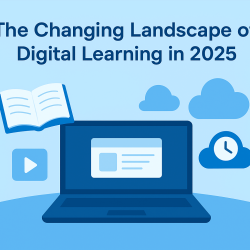Introduction: A New Era for Education
In just a few decades, education has transformed more than it did in centuries before. Classrooms that once depended entirely on chalkboards and textbooks are now powered by laptops, tablets, and cloud-based platforms. In 2025, the term “digital learning” no longer refers to a novelty—it defines the mainstream approach to education.
From young children attending virtual classes to professionals upskilling through micro-courses, the future of learning is here. But what exactly makes digital learning so impactful in 2025? Let’s explore the trends, challenges, and opportunities shaping this space.
The Shift from Emergency to Essential Learning
When the COVID-19 pandemic forced schools and universities online, digital learning was seen as a temporary solution. Fast-forward to 2025, and it has become an essential pillar of global education systems.
According to UNESCO, over 1.5 billion students experienced disruption in 2020, which led to an unprecedented investment in digital platforms. That initial momentum didn’t fade. Instead, it created a permanent infrastructure for online learning.
Today, hybrid classrooms—where physical and online learning coexist—are the standard. Students not only attend lectures but also access recorded lessons, AI-based assessments, and peer-to-peer collaboration tools. The flexibility offered has made education more inclusive than ever before.
Virtual Classrooms as the New Normal
The concept of a classroom has expanded beyond walls. Platforms like Zoom, Microsoft Teams, and Google Classroom paved the way, but by 2025, advanced tools now dominate the market.
Modern virtual classrooms offer:
-
Interactive whiteboards that mimic real classrooms.
-
Breakout sessions for group discussions.
-
AI tutors that help students with practice exercises.
-
Analytics dashboards that show teachers which students need extra help.
For learners, this means personalized attention. For educators, it means better insights into performance. And for parents, it creates a transparent system where progress can be monitored in real-time.
Smart Technology and Personalized Learning
Technology is no longer an accessory in education—it’s the backbone. Artificial Intelligence (AI), Machine Learning (ML), and Virtual Reality (VR) are transforming how knowledge is delivered.
-
AI in Education: Adaptive learning platforms analyze student performance and tailor content accordingly. If a student struggles with algebra, the system automatically adjusts lessons to provide additional practice before moving forward.
-
VR and AR: Imagine a history class where students walk through ancient Rome using VR headsets, or a medical student practicing surgeries on a virtual patient. This level of immersion makes complex concepts easier to grasp.
-
Gamification: Education platforms now integrate rewards, levels, and challenges to keep learners motivated.
The outcome? Students are not just memorizing facts—they’re experiencing them.
Digital Visibility: The Hidden Foundation of Learning Success
While innovation in classrooms gets the spotlight, one silent factor shapes who benefits from these advancements—digital visibility. Educational institutions must now compete globally, not just locally. A training center in India might be reaching students in the US, while a UK university might attract learners from Asia.
This is where platforms like Seovolume play a subtle but critical role. Just as students need access to the best digital resources, institutions need tools that make them visible to the right learners. By improving online discoverability, schools, colleges, and training platforms ensure that their courses reach audiences who may never have found them otherwise.
In 2025, visibility is as important as quality. Without it, even the best courses risk being overlooked.
The Rise of Lifelong Learning
Gone are the days when education ended with a degree. In today’s fast-changing economy, lifelong learning is the norm. A survey by LinkedIn revealed that 94% of employees would stay longer at a company that invests in their career growth. This demand fuels the popularity of micro-courses, bootcamps, and online certifications.
Some of the most in-demand lifelong learning trends include:
-
AI and Data Science Courses for professionals adapting to automation.
-
Digital Marketing Certifications for entrepreneurs and freelancers.
-
Soft Skills Training such as leadership and communication, critical for managers.
This cultural shift means education providers need to continuously adapt their offerings. Learners are no longer “one-time customers”—they are long-term partners in a journey of growth.
Challenges in the Digital Learning Landscape
Despite its advantages, digital learning still faces hurdles:
-
Accessibility Gaps – Not all students have access to reliable internet or devices. This digital divide leaves many behind.
-
Information Overload – With thousands of online courses available, students often struggle to identify credible programs.
-
Engagement Struggles – Without face-to-face interaction, some students lose motivation.
-
Cybersecurity Risks – With sensitive data online, institutions must prioritize security measures.
Innovative policies and technology partnerships are attempting to close these gaps, but progress remains uneven across regions.
The Human Element in Digital Learning
For all the focus on technology, one truth remains: education is deeply human. Great teachers, mentors, and peers still shape learning outcomes. In fact, the best digital platforms in 2025 emphasize community and collaboration.
Peer forums, discussion boards, and collaborative projects ensure that students don’t just learn in isolation but also develop social and teamwork skills. Blending human mentorship with digital tools is what creates truly impactful education.
Case Studies: Success in Digital Learning
-
Example 1: A Small Institute in Asia – By adopting online visibility strategies and hybrid teaching models, a regional institute expanded its student base to three continents.
-
Example 2: Corporate Training Programs – Businesses now partner with online learning providers to upskill employees, reducing hiring costs and improving retention.
-
Example 3: Global Universities – Top universities stream lectures worldwide, democratizing education and reaching millions who could never attend physically.
These examples highlight how strategy, visibility, and technology combine to define success in modern education.
Looking Ahead: The Future of Digital Learning
As we move deeper into the decade, expect even more innovation:
-
AI-powered mentors guiding students 24/7.
-
Blockchain certificates that make credentials tamper-proof.
-
Fully immersive metaverse classrooms.
But no matter the tools, the purpose of education will remain constant: empowering individuals to grow and contribute to society.
Just as lifelong learning is continuous, so too will digital education evolve. And with supportive platforms like Seovolume helping institutions be discovered, the future of education looks brighter, more connected, and more inclusive.
Conclusion
The digital learning landscape in 2025 represents both opportunity and responsibility. Institutions must embrace change, not resist it. Learners must stay curious and adaptable. And policymakers must work to ensure access for all.
The tools are ready, the learners are eager, and the future is waiting. Education has never been more global, more digital, or more essential than it is today.








